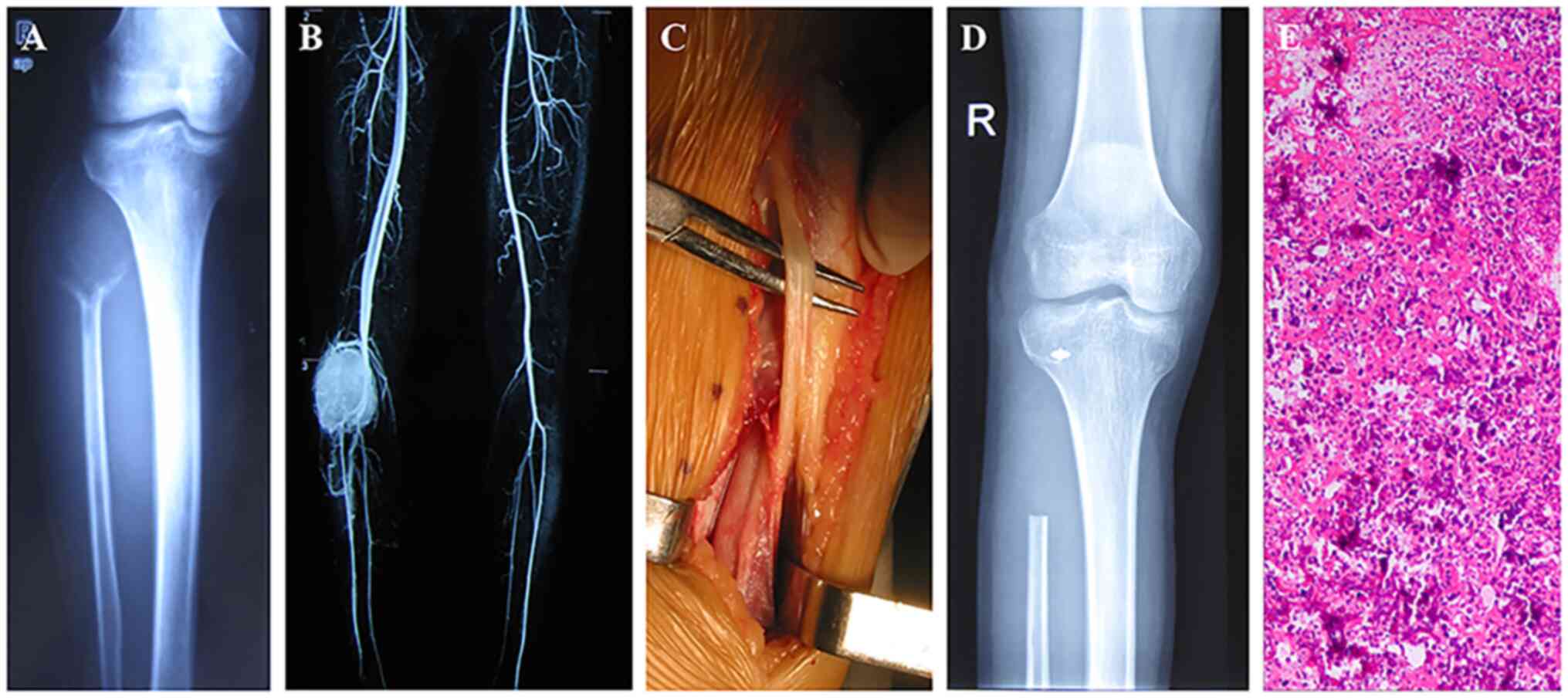|
1
|
Gümüştaş SA, Çevik HB and Kayahan S: An
epidemiological study of primary bone tumors of the fibula. Arch
Bone Jt Surg. 9:548–553. 2021.PubMed/NCBI View Article : Google Scholar
|
|
2
|
Arikan Y, Misir A, Ozer D, Kizkapan TB,
Yildiz KI, Saygili MS, Incesoy MA, Dincel YM, Gursu SS and Sahin V:
The incidence and distribution of primary fibula tumors and
tumor-like lesions: A 35-year experience. J Orthop Surg (Hong
Kong). 26(2309499018798180)2018.PubMed/NCBI View Article : Google Scholar
|
|
3
|
Abdel MP, Papagelopoulos PJ, Morrey ME,
Inwards CY, Wenger DE, Rose PS and Sim FH: Malignant proximal
fibular tumors: Surgical management of 112 cases. J Bone Joint Surg
Am. 94(e165)2012.PubMed/NCBI View Article : Google Scholar
|
|
4
|
Huntley K, Al-Hardan W and Pretell-Mazzini
J: Surgical management of benign tumors of the proximal fibula. J
Am Acad Orthop Surg Glob Res Rev. 5(e21)2021.PubMed/NCBI View Article : Google Scholar
|
|
5
|
Marinova VV, Slavchev SA, Patrikov KD,
Tsenova PM and Georgiev GP: Neoadjuvant and adjuvant treatment with
denosumab in aggressive giant-cell tumor of bone in the proximal
fibula: A case report. Folia Med (Plovdiv). 60:637–640.
2018.PubMed/NCBI View Article : Google Scholar
|
|
6
|
Arikan Y, Misir A, Gur V, Kizkapan TB,
Dincel YM and Akman YE: Clinical and radiologic outcomes following
resection of primary proximal fibula tumors: Proximal fibula
resection outcomes. J Orthop Surg (Hong Kong).
27(2309499019837411)2019.PubMed/NCBI View Article : Google Scholar
|
|
7
|
Steffner RJ and Jang ES: Staging of bone
and soft-tissue sarcomas. J Am Acad Orthop Surg. 26:e269–e278.
2018.PubMed/NCBI View Article : Google Scholar
|
|
8
|
Malawer MM: Surgical management of
aggressive and malignant tumors of the proximal fibula. Clin Orthop
Relat Res. 172–181. 1984.PubMed/NCBI
|
|
9
|
Xu L, Li X, Wang Z, Xiong J and Wang S:
Functional evaluation for patients with lower extremity sarcoma:
Application of the Chinese version of Musculoskeletal Tumor Society
scoring system. Health Qual Life Outcomes. 15(107)2017.PubMed/NCBI View Article : Google Scholar
|
|
10
|
Wang W, Liu L, Chang X, Jia ZY, Zhao JZ
and Xu WD: Cross-cultural translation of the Lysholm knee score in
Chinese and its validation in patients with anterior cruciate
ligament injury. BMC Musculoskelet Disord. 17(436)2016.PubMed/NCBI View Article : Google Scholar
|
|
11
|
LaPrade RF, Heikes C, Bakker AJ and
Jakobsen RB: The reproducibility and repeatability of varus stress
radiographs in the assessment of isolated fibular collateral
ligament and grade-III posterolateral knee injuries. An in vitro
biomechanical study. J Bone Joint Surg Am. 90:2069–2076.
2008.PubMed/NCBI View Article : Google Scholar
|
|
12
|
Futani H, Kumanishi S, Minakawa GO and
Yoshiya S: Osteoscopic surgery of giant cell tumor of bone for
preservation of proximal fibula. Anticancer Res. 38:2995–3000.
2018.PubMed/NCBI View Article : Google Scholar
|
|
13
|
Yao H, Wang B, Wen L, Jin Q, Li H, Huang
G, Yin J, Zou C, Xie X and Shen J: Comparison of clinical features,
management and outcomes of osteosarcoma located in proximal fibula
and proximal tibia: A propensity score matching analysis. BMC
Cancer. 18(1195)2018.PubMed/NCBI View Article : Google Scholar
|
|
14
|
Malawer M, Buch R, Reaman G, Priebat D,
Potter B, Khurana J, Shmookler B, Patterson K and Schulof R: Impact
of two cycles of preoperative chemotherapy with intraarterial
cisplatin and intravenous doxorubicin on the choice of surgical
procedure for high-grade bone sarcomas of the extremities. Clin
Orthop Relat Res. 214–222. 1991.PubMed/NCBI
|
|
15
|
Atalay IB, Yilmaz S, Korkmaz I, Ekşioğlu
MF and Güngör BŞ: Surgical management of primary malignant proximal
fibular tumors: Functional and clinical outcomes of 23 patients.
Eklem Hastalik Cerrahisi. 30:24–31. 2019.PubMed/NCBI View Article : Google Scholar
|
|
16
|
Takahashi S, Ogose A, Tajino T, Osanai T
and Okada K: Osteosarcoma of the proximal fibula. An analysis of 13
cases in the northern Japan. Ups J Med Sci. 112:366–372.
2007.PubMed/NCBI View Article : Google Scholar
|
|
17
|
Dieckmann R, Gebert C, Streitburger A,
Budny TB, Henrichs MP, Vieth V, Gebert C and Hardes J: Proximal
fibula resection in the treatment of bone tumours. Int Orthop.
35:1689–1694. 2011.PubMed/NCBI View Article : Google Scholar
|
|
18
|
Bickels J, Kollender Y, Pritsch T, Meller
I and Malawer MM: Knee stability after resection of the proximal
fibula. Clin Orthop Relat Res. 454:198–201. 2007.PubMed/NCBI View Article : Google Scholar
|
|
19
|
Tang X, Guo W, Yang R and Wang Y: Poor
prognosis and complications are common in limb salvage surgery for
malignant tumors of the proximal tibia invading the fibula. Arch
Orthop Trauma Surg. 134:299–304. 2014.PubMed/NCBI View Article : Google Scholar
|
|
20
|
Faezypour H, Davis AM, Griffin AM and Bell
RS: Giant cell tumor of the proximal fibula: Surgical management. J
Surg Oncol. 61:34–37. 1996.PubMed/NCBI View Article : Google Scholar
|
|
21
|
Einoder PA and Choong PF: Tumors of the
head of the fibula: Good function after resection without ligament
reconstruction in 6 patients. Acta Orthop Scand. 73:663–666.
2002.PubMed/NCBI View Article : Google Scholar
|
|
22
|
Draganich LF, Nicholas RW, Shuster JK,
Sathy MR, Chang AF and Simon MA: The effects of resection of the
proximal part of the fibula on stability of the knee and on gait. J
Bone Joint Surg Am. 73:575–583. 1991.PubMed/NCBI
|
|
23
|
Ben Amotz O, Ramirez R, Husain T, Lehrman
C, Teotia S and Sammer DM: Complications related to harvest of the
proximal end of the fibula: A systematic review. Microsurgery.
34:666–669. 2014.PubMed/NCBI View Article : Google Scholar
|
















